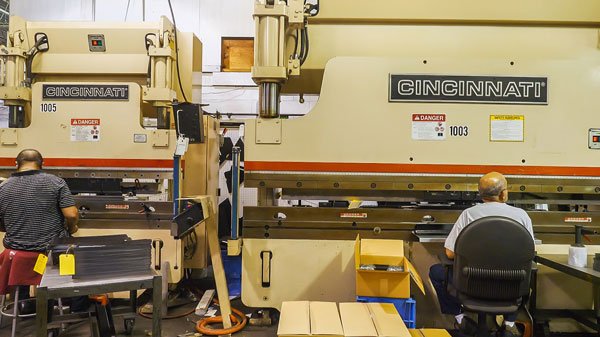Cutting & Fabricating Sheet Metal Is Faster With Lasers
Cutting & Fabricating Sheet Metal Is Faster With Lasers
Blog Article
In the rapidly evolving field of metal fabrication, companies are increasingly investing in advanced technology to stay ahead of the competition. The need for speed, precision, and cost-efficiency is driving the shift towards laser cutting equipment, which is designed to optimize both performance and productivity in sheet metal cutting. Traditional methods are struggling to match the efficiency provided by modern laser technology, making it a vital tool for today’s fabricators.
The Revolution of Laser Cutting in Metal Fabrication
Laser cutting technology has significantly transformed the sheet metal fabrication industry. Unlike conventional cutting methods that use mechanical tools, laser cutting employs concentrated beams of light to achieve precise and rapid results. This method enables fabricators to make intricate cuts, produce smoother edges, and achieve higher accuracy. For businesses offering laser cutting services for metal, adopting this technology is crucial for maintaining competitive edge.
For instance, a metal parts manufacturer in PA can leverage laser cutting to handle various metals, including stainless steel and aluminum. The ability to execute detailed designs with speed and consistency makes laser cutting an invaluable asset for custom metal work, catering to diverse industry needs.
Mergers and Partnerships with Larger Entities
To meet the increasing demand for advanced technologies, many smaller metal fabricating businesses have opted to merge with or partner with larger firms. These collaborations provide the necessary resources and capital to invest in state-of-the-art technologies, such as fiber laser cutting machines, automation systems, and robotics. In today’s competitive landscape, adopting such technologies is essential for staying relevant and efficient.
Larger firms have the financial means to integrate these cutting-edge tools, offering enhanced speed, precision, and efficiency for complex custom metal work. This trend of consolidation is helping fabricators streamline operations, cut lead times, and broaden their service offerings. For example, many stainless steel fabricators are now utilizing fiber laser cutting to manage high-volume production runs effectively without sacrificing quality.
Advantages of Fiber Laser Cutting Machines
Fiber laser cutting machines are increasingly popular among metal fabricators due to their exceptional performance and results. These machines are designed to deliver faster cutting speeds, which is crucial for working with thin to medium-thickness materials. Fiber lasers excel in cutting stainless steel, aluminum, and other metals more efficiently than traditional CO2 lasers, making them a preferred choice for many fabricators.
Key benefits of fiber lasers for companies providing laser cutting services for metal include:
- Faster Cutting Speeds: Fiber lasers outperform CO2 lasers in speed, especially for thinner materials, leading to reduced production times and increased overall efficiency.
- Higher Precision: With a smaller beam size, fiber lasers achieve tighter tolerances and finer details, making them ideal for precision-required industries such as electronics and medical devices.
- Energy Efficiency: Fiber lasers are more energy-efficient than CO2 lasers, lowering operating costs and supporting environmental sustainability.
- Versatility: Capable of cutting a broad range of materials, including reflective metals like brass and copper, fiber lasers are versatile tools for custom metal work and complex designs.
The Role of Automation and Robotics in Metal Fabrication
Beyond laser cutting, the integration of robotics and automation is transforming the metal fabrication industry. Automation ensures continuous production with minimal downtime, allowing businesses to undertake more projects without compromising on quality. As demand for stainless steel fabricators rises, the ability to deliver high-quality products efficiently becomes increasingly important.
Many larger fabricators are incorporating robotics into their production processes to achieve consistent output and lower labor costs. For smaller businesses that have merged with larger companies, this move towards automation offers the opportunity to expand capabilities and provide a wider range of services, including custom metal work.
Why Fiber Laser Cutting Outperforms CO2 Lasers
When choosing the best technology for sheet metal fabrication, fiber laser cutting machines are superior to CO2 lasers for several reasons:
- Speed: Fiber lasers cut through materials faster than CO2 lasers, particularly for thin and medium-gauge metals. This increased speed results in shorter lead times and higher productivity, making fiber lasers ideal for high-volume applications.
- Lower Operating Costs: With greater energy efficiency and reduced maintenance requirements, fiber lasers lower overall operating costs and contribute to a more sustainable production process.
- Improved Precision: Fiber lasers provide a smaller focal point for tighter tolerances and finer detail, essential for industries that demand high precision, such as automotive and aerospace.
- Versatility: Fiber lasers can process a wider range of materials compared to CO2 lasers, including highly reflective metals like brass and copper. This versatility is crucial for fabricators offering laser cutting services for metal, enabling them to tackle diverse projects.
As investments in advanced technologies continue, fiber laser cutting machines are becoming indispensable in sheet metal fabrication. Their superior speed, precision, and energy efficiency set them apart from traditional CO2 lasers. Whether for a metal parts manufacturer in PA or stainless steel fabricators engaged in custom metal work, fiber lasers deliver the performance and versatility required to excel in today’s dynamic market. With ongoing advancements in automation and robotics, fabricators are better equipped to deliver high-quality work faster than ever before, meeting the growing demands across various industries.
Report this page